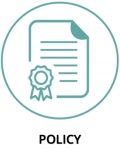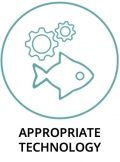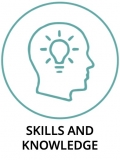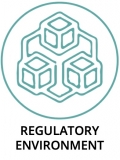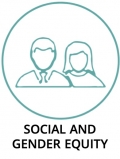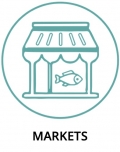Circular Economy and the Fish Value Chain
A circular economy is based on the principles of designing out waste and pollution, keeping products and materials in use, and regenerating natural systems. This approach aims to maintain the value of products and materials for as long as possible by returning them into the product cycle at the end of their use, and minimizing the generation of waste.
A circular economy for food, including fishery and aquaculture products, mimics natural systems of regeneration so that waste does not exist, and is instead feedstock for another cycle. It is designed so that organic resources are free from contaminants and can safely be returned at the end of its lifecycle in the form of organic fertilizer. Some by-products can provide additional value by creating new food products, non-food products including pharmaceuticals, fertilisers and bioenergy. These cycles regenerate living systems which provide renewable resources and support biodiversity.
A circular approach would seek to avoid loss or waste of food, and reduce the likelihood of spoilage, such as from traveling distance to market or inadequate cold chains, as well as avoid food waste at the point of sale and at the consumer level. The approach avoids landfilling and aims to extract the maximum value from fish and fish materials.
Opportunities
Opportunities
Job Creation and Market Expansion
Markets for fish by-product and fish waste are increasingly becoming larger as the desire for these products grows, and as new technology emerges to better utilize fish waste and by-products. This demand not only helps to reduce the waste, but creates jobs as the markets expand.
Fish by-product and fish waste uses include:
- Compost and Fertilizer (innards, frames, and trimmings transformed into plant feed)
- Animal food (divert waste meat and oils to pet food)
- Supplements (Omega-3, omega-6, marine collagen)
- Beauty (fish scales for lipstick and gloss)
- Leather (tan fish skins to use for shoes, wallets, etc)
- Gelatin (used in pharmaceuticals or candies)
- Ink (sepia dye from cuttlefish, squid ink for food)
Returning Nutrients to the Environment
Composting is a biological process during which naturally occurring microorganisms (such as bacteria and fungi), insects, snails, and earthworms break down organic materials into a soil-like material. As a form of recycling, this is a natural way to return nutrients to the environment.
Anaerobic digestion is the process of breaking down organic material in the absence of oxygen, which produces biogas and solid residual. Biogas, which consists of methane and carbon dioxide, can be used as a source of energy (similar to natural gas). The solid residual can be applied on the land or composted and used as a soil amendment.
Waste to Energy
Energy recovery is the conversion of non-recyclable waste materials into useable heat, electricity, or fuel through waste-to-energy processes such as combustion, gasification, pyrolysis, anaerobic digestion, and landfill gas recovery. In a non-circular system, waste is often disposed of in the landfill, therefore losing all residual energy. Waste-to-energy processes helps to recoup some of this energy, however reusing materials and avoiding landfill is known to save significantly more energy.
Greenhouse Gas Emission Reduction
Food loss and waste are a major contributor to climate change, accounting for 8 percent of global greenhouse gas emissions annually. In fisheries and aquaculture, it is estimated that 35 percent of the global harvest is either lost or wasted every year. A circular system would seek to keep food and fish waste out of landfills, therefore reducing greenhouse gas emissions both from disposal and from activities needed to produce more food. For example, if the United Kingdom kept organic food out of landfills, it would not only save USB 1.1 billion a year on landfill cost, but also reduce greenhouse gas emissions by 7.4 million tonnes.
Case Study - Iceland Cod Fisheries
Case Study - Iceland Cod Fisheries
Within the Iceland Ocean Cluster, waste from traditional cod fisheries and cod processing is used for biomass feedstock. The feedstock is food waste from wild caught cod, which is sustainably caught throughout the year. These well-established fisheries and cod processing industries produce a constant stream of waste that has to be managed. Industries with innovative technologies, such as Codland, can transform this waste into high-value compounds. To gain access to a secure a constant supply of the waste generated by cod processing industries, Codland is situated close to them in the port. Using biomass residues and waste, including food loss and waste (FLW), when it is both economically and environmentally feasible and viable, can allow producers to diversify their incomes without changing their production. For example, some of the products obtained from the waste from cod manufacturing industries are beneficial for human health (e.g. nutraceuticals, such as collagen peptides) and can improve the soil microbiome. To produce these nutraceuticals, the process uses enzymes instead of chemicals. Fish oil with omega-3 fatty acids and mineral supplements (mainly calcium) are also produced.
Solution Entry Points
In order to promote the circular economy and apply the approach to food loss and waste in fish value chains, a number of initiatives can be used and combined, some of which are summarised below:
| |
| |
| |
| |
| |
| |
|
Key Publications
|
The Ellen MacArthur Foundation’s report on Economics of a Circular Economy invites readers to imagine an economy where today’s goods are tomorrow’s resources, forming a virtuous cycle that fosters prosperity in a world of finite resources. | |
Towards Sustainable Bioeconomy This report offers lessons from 26 case studies of sustainable bioeconomy interventions from a range of different sectors. It aims to expand the general understanding of sustainability in the context of the development of the bioeconomy. | |
Achieving Blue Growth Building Vibrant Fisheries and Aquaculture Communities FAO’s Blue Growth Initiative emphasizes the three pillars of sustainable development– economic, environmental and social – so that fisheries and aquaculture contribute to the 2030 Agenda Sustainable Development Goals (SDGs). |


